Now & New
- Experience
Hiroshima Castle and Shukkeien Tsukimi: Celebrations Under the Full Moon
Autumn always begins in September, but even though trees in Hiroshima have yet to change color, this month is renowned for marking the start of fall through its lunar festivals. This year, Autumnal Equinox Day—a public holiday—was on the 23rd of September, and six days after that was when “Tsukimi,” the moon viewing holiday, began, lasting until the 2nd of October. Tsukimi is derived from the Chinese Mid-Autumn Festival, and thus, shares dates and the custom of harvest moon-viewing parties with its Chinese counterpart, albeit with a few differences in symbolism.
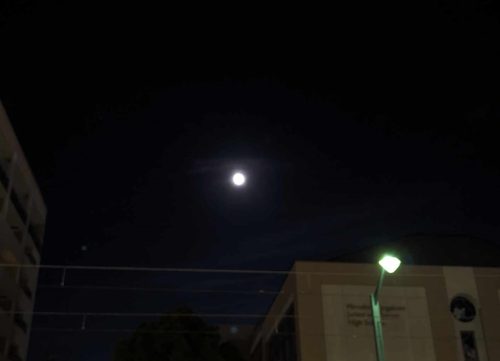
Commercial Tsukimi
In Japan, Tsukimi is characterized by chestnuts, Japanese pampas grass, and Tsukimi dango (round, white rice dumplings), which are put on display in houses, schools, and public places where Tsukimi events take place. Preschools, daycare centers, and elementary schools always have their children make special full moon-related arts and crafts during September in anticipation for this holiday. Finally, when it comes to that special shape people see in the moon’s craters, Japanese people traditionally believe it is a rabbit pounding mochi with a wooden mallet, which is why the aforementioned arts and crafts are likely to feature rabbits too.
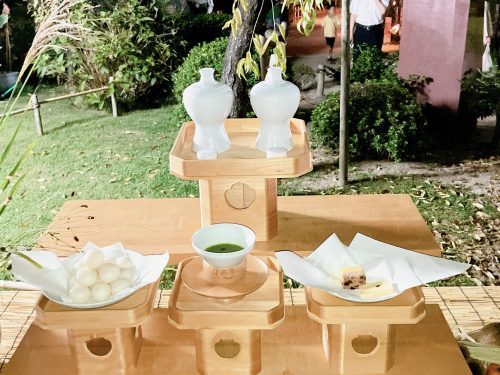
But that’s not all, for any holiday in Japan, whether or not it results in a day off, will be the subject of marketing campaigns of every industry imaginable, but especially of the food service industry. Naturally, since many households will have the urge to decorate for Tsukimi, discount stores, interior design stores, and supermarkets will have the relevant merchandise for sale before the beginning of September. Similarly, restaurants also begin rolling out their special Tsukimi items for a limited time during the days leading up to Tsukimi, most of which feature a raw or sunny-side up egg on top of an existing menu item. Of course, some recipes that already call for an egg to be placed atop the food will continue to be served year-round, so diners can enjoy Tsukimi-style foods like soboro-don (a rice bowl topped with ground chicken, red pickled ginger, and a raw egg) any month of the year. If that’s not enough holiday spirit for you, local tourist attractions such as Hiroshima Castle and Shukkeien will even have extended hours with special events that let tourists make full use of the sites under the light of the full moon.

Moonlit Concert
On Saturday, the 30th of September, which was the second day of Tsukimi, Hiroshima Castle held its Tsukimi event with exclusive events happening both inside and outside the keep. Though the castle grounds are technically open 24/7, on this night, there was a special Tsukimi concert to be held inside the Gokoku Shrine adjacent to the castle, completely free of charge. For once, I had business inside the shrine building (it’s normally reserved for families conducting certain ceremonies), so no way would I pass up my chance to see the interior. That night, I entered the grounds of Hiroshima Castle from the eastern stone torii, climbed some stairs, walked past the castle keep that I would explore later, and descended from shallow stone steps that were lit with paper lanterns decorated with carp swimming in water that reflected the full moon in the night sky.

I wasn’t exactly the first to show up to the venue, but early enough to nab a bench seat, and although I wasn’t in the front or center, my view of the performers was still quite clear. There was a man on an electronic keyboard and a woman playing the erhu (called “niko” in Japanese), a bowed instrument with origins in China. The duo played both old-timey and modern pieces, including songs from older anime that fans of all ages recognize, but the common theme uniting all the songs is that of the moon. For one of the performances, there was an additional woman in a kimono who did calligraphy on the spot with golden ink on a blue canvas while the musicians played.
The artist finished her work by the end of the song, and when the music stopped, she was given the microphone to explain the significance behind her calligraphy. As one could guess, the words, which I had trouble reading due to the cursive strokes, referred to a night with a shimmering, full moon in the sky, accompanied by romantic music that evoked feelings of longing. Even if I couldn’t make heads or tails out of what was written (nor could many other foreign tourists in the audience), the fluid strokes of ink were a radiant work of art to be appreciated in their own right.

Moment Joy: Feeling the Moonlight
Throughout the concert, the music put on by the duo provided a romantic atmosphere befitting of Tsukimi that seemingly brought the full moon to us even though we were indoors. It also helps that the erhu is one of my favorite instruments, and no matter what song it plays, the notes that come out of an erhu always sound beautifully somber and moving, enough to give me goosebumps. I could have closed my eyes during any of the songs and imagined myself outside in a field of flowers or at the edge of a lake, with no one to keep me company except the full moon itself. In spite of the numerous people in the crowd holding up their cameras to take pictures and videos, I had a strong desire to put away my devices for the majority of the concert and just be in the moment, shooting only what was necessary to write this article.
Hiroshima Castle Night Museum

When the concert ended, there was an announcement stating that there would be another at a later time, but I knew I wouldn’t have time for that as I would be busy exploring Hiroshima Castle. I got up from my bench and inched my way out of the Gokoku Shrine building, then up the stairs to the castle keep, which is photogenic at night regardless of the phase of the moon. After purchasing my ticket, I was given two gifts: a commemorative clear file folder and a slip of paper with a Tsukimi-themed seal, both of which featured Shirou-nya, Hiroshima Castle’s cute, feline mascot. Inside the file folder was a blue sheet of paper outlining the Night Museum exclusive exhibits and events, but before getting to those, I took a walk around the first floor to check out the normal exhibits.

One of the first things inside to catch my attention was this topographic map of what would become Hiroshima City back in the 16th century. A lot of the place names on this map were familiar, but the shape of our city was vastly different considering how much of it was underwater at the time. Locales such as Hijiyama Hill, Motoujina, and Ebayama Park were called Hiji Island, Ujina Island, and Eba Island, respectively, and this thematic map did an excellent job reminding visitors how much of our city’s land was reclaimed before being urbanized. Everyone who walked by this map stopped to gasp in amazement and try to see if their current home would have been submerged back then.

I then ascended to the second floor to see the first of the Tsukimi-exclusive exhibits, which was this display of a Japanese yokai banquet. Here we have an Amabie yokai, a haunted cat, an umbrella yokai, and possibly other unseen creatures gathered on this night to partake in Tsukimi dango and other delicacies when people would otherwise not be in the castle. On this same floor inside a separate room was a suit of samurai armor belonging to Goto Shoken, an Edo-period doctor of the Hiroshima Domain. His kabuto (兜 – helmet) sports a golden disc representing the sun right above a distinct crescent moon, showing the timelessness of Japanese people’s love for the moon.
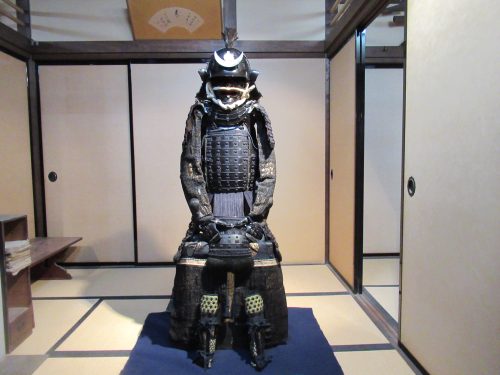
The fourth floor had a temporary exhibit dedicated to the history of Hiroshima Castle in the modern era, but that actually began on the 22nd of July and would continue to the 1st of October, so it wasn’t exactly a Tsukimi thing. Above that was the rooftop observation deck, where visitors could look down on the moat and city from all directions. Unfortunately, I couldn’t see the full moon from up here, and my photos of the city lights were full of glares. The best picture I took was this view to the south, where one can see the stairs leading up to the keep and volunteers standing around to greet visitors.
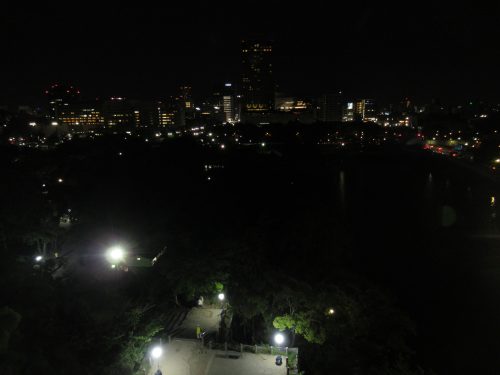
When I was up here, I heard announcements on the loudspeaker about a special guest on the first floor: Shirou-nya was greeting visitors and posing for photos! I rushed down the stairs to the first floor and got in line to get my pictures of and with the lovable mascot. There were quite a few little kids taking their time with Shirou-nya, which gave me ample time to bust out my camera and decide what kinds of poses to make when my turn came around. This feisty feline was friendly with folks of all sorts, even grown-up me, and after I got my share of photos with Shirou-nya, the mascot waved at me as I left, so I turned around and did the same.

Moonlit Garden
Hiroshima Castle wasn’t the only tourist site in the area to have something going on for Tsukimi, for on the 29th of September, Shukkeien had yet another thematic tea ceremony, but this time outdoors and at night to capitalize on the moonlit sky. This meant that the garden itself also had later hours of operation, just like it does during sakura season and when autumn foliage hits its peak. Since not every nook and cranny of Shukkeien is illuminated, for safety reasons, visitors at night are limited to paths that actually have lights. That was fine, though, for the best parts of Shukkeien tend to be in the brightly lit areas to begin with. One of the more spectacular views of Shukkeien that night would definitely have to be the central bridge going right through the huge pond; in addition to the full moon in the sky, there was even pampas grass at the water’s edge to add that extra Tsukimi pizazz.
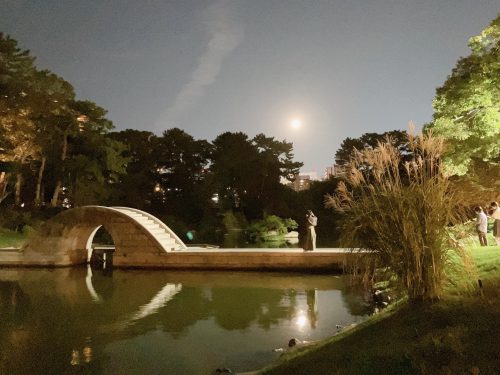
Besides the registration tents and benches for the tea ceremony itself, Shukkeien also had a table with all the essential symbols of Tsukimi (pictured above) and special lanterns placed throughout the garden to commemorate the one-night occasion. They totally didn’t have to make a special design for an event that would only happen once, but this is just how seriously Shukkeien takes tea ceremonies.
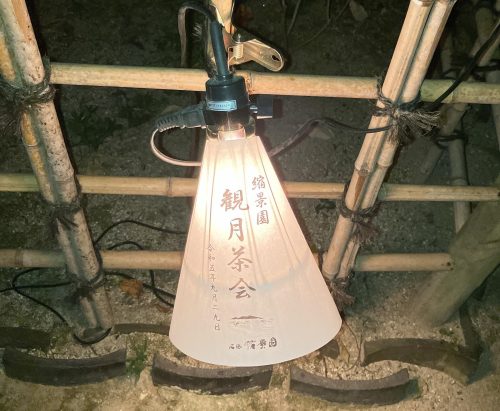
Those taking part in the tea ceremony sat on benches covered with this red, velvety fabric whilst gazing up at the harvest moon. The wagashi (和菓子 – Japanese sweet) that accompanied the tea this time was unlike anything I had seen at tea ceremonies thus far, and honestly looked like a piece of wood upon first glance. Of course, it tasted better than it looked, and basking in the evening moonlight while sipping hot green tea was the real treat anyway. This Tsukimi tea ceremony was one of the only—if not the only—tea ceremony that gets held outdoors at night inside Shukkeien. People can sit and drink tea in the garden during the sakura and autumn foliage illuminations, but no ceremony is involved there.

It truly is a delight to have so many seasonal events based on Japanese tradition in traditional Japanese venues like Hiroshima Castle and Shukkeien. Being able to enter these tourist sites allows visitors to witness a different side of the places and gain a new appreciation for what might otherwise be thought of as just another tourist site in Hiroshima. Given the relative scarcity of autumn festivals in September compared to the next couple months, the presence of Tsukimi-related events is crucial in keeping these sites popular and relevant. Thanks to the abundance of these nocturnal festivities, however, a visit to Hiroshima City in September can be magical and memorable, for the lack of autumn colors is made up for with a shining full moon, giving Mother Nature the green light to let autumn begin.
Written by the Joy in Hiroshima Team
